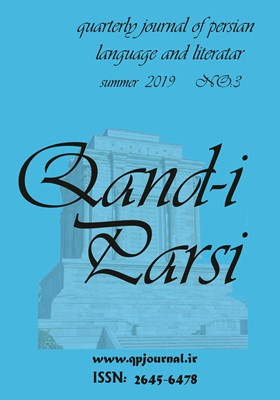Review of the narrative time period in the Scriptwriter script by Siavash Kasraei on the basis of Gerard Genet's theory
Subject Areas : تحلیل متون نظمhosin rasolzadeh 1 , hojat bodaqi 2
1 - Tabriz University
2 - Tabriz University
Keywords: genette, kasrayi siyavash, narrative, cintemporary poem.,
Abstract :
The ‘Mohreye Sorkh’ Poem is one of the highest narrative poems in contemporary literature, which Kasraei uses with a narrative and mythical method to recreate the stories of Rostam and Sohrab. Since this poem has no direct line and is accompanied by changes to Ferdowsi's narrative, the use of the theory of genes in the understanding of this system is of great help to the audience. Genette refers to three types of time relationships between the time of the story and the time of the text, which are: 1. Order 2. Durability3. Frequency. The results show that the chracariity in the order element of the tendency is to the type of post-negation. The results show that he has a tendency to type-flashforward in the order element. These flashbacks are the means for him to be able to narrate his closed destiny. In the continuity of time, numerous descriptions, including the description of their characters and their states, space and place and time, have caused the poetry to have a negative momentum and the narrative time with the time of the story and the text is almost equal. The frequency of the element of dialogue has brought the structure of this poem closer to a dramatic text. These talks, in addition to the possibility of personality, have been able to add to the lyrical load of the poetry system. In a few cases, he has been able to escape unnecessary material by using the eliminating element, and directing the audience to the main story. In the case of the frequency element, it can be said that, apart from repeating the story of the birth of Sohrab and the vertebrae, it is not frequent and recurrent, and often comes in singular frequency.
1. احمدي، بابك (1386). ساختار و تأويل متن. تهران: مركز.
2. اسداللهی، خدابخش و همکاران (1395). بررسی تداوم زمان در منظومة آرش کمانگیر. مجلة شعرپژوهی. س 8. ش 2.
3. ايگلتون، تری (١٣٨٠). پيش درآمدی بر نظرية ادبي. ترجمة عباس مخبر. تهران: مرکز.
4. باباچاهی، علی (1377). گزاره¬های منفرد. تهران: نارنج.
5. بامشکی، سمیرا (1391). روایت شناسی داستان¬های مثنوی. تهران: هرمس.
6. براهنی، رضا (1371). طلا در مس «دورة دو جلدی». ناشر: نویسنده.
7. برتنس، يوهانس ويل (1388). مباني نظرية ادبي. ترجمة محمدرضا ابوالقاسمي. تهران: ماهي.
8. برودل، ديويد (1380). روايت در فيلم داستاني ترجمة سيّدعلاء¬الدين طباطبايي. تهران: بنياد سينمايي فارابي.
9. بی¬نیاز، فتح¬الله (1392). درآمدی بر داستان¬نویسی و روایت¬شناسی. تهران: افراز.
10. پرینس، جرالد (1391). روایت شناسی، ترجمة محمد شهبا. تهران: مینوی خرد.
11. تودوروف، تزوتان (1379). بوطيقاي ساختارگرا. ترجمة محمد نبوي. تهران: آگه.
12. تولان، مايكل جي(1383). درآمدي نقادانه و زبانشناختي بر روايت. ترجمة ابوالفضل حري. تهران: نيلوفر.
13. ـــــــــــ (1386). روایت¬شناسی. درآمدی زبان¬شناختی-انتقادی. مترجمان: سیده فاطمه علوی و فاطمه نعمتی. تهران: سمت.
14. چتمن، سیمور (1390). داستان و گفتمان (ساختار روایی در داستان و فیلم). ترجمۀ راضیه سادات میر خندان. تهران: مرکز پژوهشهای اسلامی صدا و سیما.
15. جورکش، شاپور (1383). بوطیقای شعر نو «نگاهی دیگر به نظریه و شعر نیما یوشیج». تهران: ققنوس.
16. حمیدیان، سعید (1383). داستان دگردیسی «روند تحولات شعر نیما یوشیج». تهران: نیلوفر.
17. حسن¬زاده، بهروز (1387). نقد و تحلیل «مهرة سرخ»، شماره 64، صص 58 تا 60.
18. ريمون كنان، شلوميت (1387): روايت داستاني: بوطيقاي معاصر، ترجمة ابوالفضل حري، تهران: نيلوفر.
19. فردوسی، ابوالقاسم (1387). شاهنامه. ویرایش فریدون جنیدی. نشر بلخ.
20. فلکی، محمود (1373). نگاهی به نیما. تهران: مروارید.
21. قاسمی پور، قدرت (1387). زمان و روایت. نقد ادبی. شمارة 2.
22. کسرایی، سیاوش(1386). مجموعه اشعار. تهران: نگاه.
23. لاج، دیوید و همکاران (1389). نظریّههای رمان. ترجمۀ حسین پاینده. تهران: نیلوفر.
24. لوته، ياكوب (1386). مقدمه¬اي بر روايت در ادبيات و سينما. ترجمة اميد نيك¬فرجام. نشر مينوي خرد.
25. مکاریک، ایرنا ریما (1385). دانشنامة ادبی معاصر. مترجمان: مهران مهاجر و محمد نبوی. تهران: آگه.
26. میرصادقی، جمال (1387). راهنمای داستان¬نویسی. تهران: سخن.
27. نیمايوشيج (1357). حرف¬هاي همسايه. تهران: دنيا.
28. Barth, Roland (1986): ‘introduction of the structural analysis of narratives’ in images – music-text. Trans. Stephen heath, Glasgow: Fontana press.
29. Herman, D. (2002). Story Logic: Problems and Possibility of Narrative. Lincoln NE: University of Nebraska Press.
30. Rimmon-kenan, Shlomith (2002): Narrative Fiction. 2nd edition. London and New York: Routledge.
31. Dosse, Francois (1996): History of Structuralism.Tr. Deborah Glassman. Vol. 1. Minneapolis: University of Minnesota.
32. Genette, Gerard (1997): Narrative Discourse; trans. J.E.Lewin. Cambridge: Cambridge University Press.


